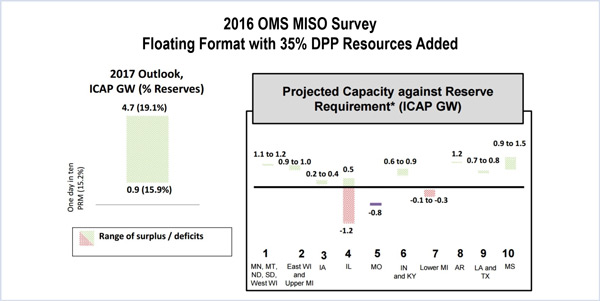MISO stakeholders will decide in an email vote whether it’s worth debating the cost allocation for holders of firm transmission service reservations of more than 1,000 MW between MISO Midwest and South.
The Load-Serving Entities sector presented a motion to the Resource Adequacy Subcommittee on Wednesday asking that MISO drop the issue, which is an outgrowth of the RTO’s settlement over the use of SPP’s transmission for North-South transfers. The LSEs said changing the cost allocation of payments to SPP would not provide significant benefits to MISO.
Kevin Murray, representing the Coalition of MISO Customers, asked that a vote on the motion be tabled until FERC acts on the uncontested settlement for cost allocation among MISO members filed in August (ER14-1736, et al.), but stakeholders overwhelmingly rejected tabling the motion, 36-2. In the settlement filing, MISO has proposed allocating a declining percentage of the costs to reimburse SPP through a load ratio calculation and an increasing amount through a flow-based benefits methodology.
Keith Berry of the Arkansas Public Service Commission pointed out FERC may not act for quite a while because the commission has been short of a quorum since former Chairman Norman Bay’s resignation in February. President Trump has not nominated any replacements to fill the commission’s three open seats.
After considerable debate, stakeholders agreed to decide the issue via email. Ballots are due April 19.
Some stakeholders said firm reservations undoubtedly diminished the 2016/17’s Planning Resource Auction’s transfer capability between the RTO’s Midwest and South regions from 1,000 MW to 876 MW, increasing clearing prices.
Last month, some stakeholders questioned whether continuing the debate over the cost allocation was worth the effort. The 1,000-MW-plus usage of the transfer path is only relevant in the 2018/19 planning year, when firm reservations were granted in excess of 1,000 MW. (See “MISO Examines Single Year of MISO-SPP Settlement Allocation,” MISO Resource Adequacy Subcommittee Briefs.)
Any change would affect no more than 304 MW, because the potential TSRs over the North-South path for the year total 1,304 MW, the LSEs said.
MISO is currently in the fourth year of its settlement agreement with SPP over flows of more than 1,000 MW using SPP transmission to ferry energy between MISO Midwest and MISO South.
MISO Manager of Resource Adequacy Coordination Laura Rauch said the RTO and stakeholders have to reach a decision by November, filing either a cost allocation change or a notice explaining it would not pursue the issue. RASC Chair Chris Plante said the Regional Expansion Criteria and Benefits Working Group could be charged with working out the details if stakeholders decide to pursue a cost allocation change.
Next April, MISO stakeholders will tackle a related issue, deciding if and how to allocate costs to benefiting entities if the RTO raises the amount of capacity that can be transferred between the South and Midwest sub-regions to more than 1,000 MW in capacity auctions after April 2018.
MISO Still Tweaking OMS-MISO Survey Format
MISO is still tinkering with the format of its annual resource adequacy survey with the Organization of MISO States.
The RTO is proposing a “floating” format in which committed retirements and additions with signed interconnection agreements are left out of the bar graphs and the survey instead focuses on the range of possibilities from planned additions and potential retirements.
“People tend to gravitate toward the low end of the range. We’re really not trying to point people to the low end of the range or the high end of the range,” RASC Chair Shawn McFarlane said.
Survey results are expected in June. MISO plans to add a 35% share of projects in the definitive planning phase of the interconnection queue into survey results, although stakeholders have said the completion estimate is too low. (See Differences Persist over OMS-MISO Survey Improvements.) Incorporating the 35% calculation would have shifted 2016 results from a possible 15.9 to 17.4% planning reserve margin range to 15.9 to 19.1%. MISO requires a 15.2% reserve margin.
Rauch said MISO will continue to work on the survey format even after results are released in late spring. “We have had it evolve over the years with incremental changes,” said Rauch, pointing out that the RTO now focuses on the first five years of survey, rather than the full 10 years. It also shares data for each local resource zone while reporting inter-zonal transfers.
Stakeholders asked if MISO considers other variables, including external resources and wind at full capacity. Rauch said the RTO does consider transfers from other balancing authorities when calculating survey results.
— Amanda Durish Cook




